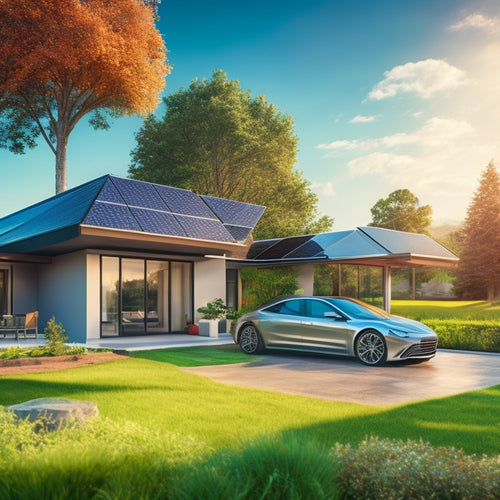
Why Cities Need Smart Charging Infrastructure Now
Share
You're about to experience a tidal wave of electric vehicles hitting your city's streets, and it's essential you're prepared. Without smart charging infrastructure, you'll face inadequate charging stations, congested roads, and strained grids. It's not just about keeping up with the projected 50% of new car sales being electric by 2040 - it's about future-proofing your city. You need a charging system that can handle increased demand, balance energy distribution, and optimize power supply. The benefits are clear: reduced congestion, improved air quality, and a greener urban environment. Now, discover how smart charging infrastructure can revolutionize your city's sustainable future.
Key Takeaways
• Cities need smart charging infrastructure to support the surge in EV adoption rates, with over 50% of new car sales predicted to be electric by 2040.
• Inefficient charging systems and limited accessibility hinder urban EV adoption, making smart charging a necessity for cities.
• Smart charging infrastructure can reduce congestion, improve air quality, and increase economic opportunities, creating a greener urban environment.
• Future-proofing city infrastructure with smart charging can accommodate the projected 20 million EVs on US roads by 2030, ensuring a stable power supply during peak hours.
• Implementing smart charging infrastructure now can help cities combat climate change and secure climate resilience through data-driven decisions.
Urban EV Charging Challenges
As you navigate urban landscapes, you're likely to encounter a plethora of electric vehicle (EV) charging challenges, including inadequate infrastructure, limited accessibility, and inefficient charging systems. One of the most pressing issues is parking woes. With limited parking spots available, EV owners often find themselves circling the block, waiting for a charging spot to open up. This not only wastes time but also increases congestion and air pollution.
Furthermore, the strain on the grid is a significant concern. As more EVs hit the roads, the demand for electricity surges, putting a strain on the grid. This can lead to brownouts, blackouts, or even grid failures. In addition, the lack of smart charging infrastructure means that EVs are often charged during peak hours, exacerbating the grid strain.
To mitigate these challenges, cities need to invest in smart charging infrastructure that can manage the flow of energy, reduce congestion, and optimize charging times. By doing so, we can create a more sustainable, efficient, and convenient charging experience for EV owners.
Infrastructure Requirements for EVs
What specific infrastructure requirements must cities prioritize to support the growing demand for EVs, making sure seamless and efficient charging experiences?
As you navigate the shift to electric mobility, understanding the necessary infrastructure is vital. To start, cities must focus on grid resiliency, guaranteeing that their electrical grids can handle the increased demand from EV charging. This involves upgrading existing infrastructure to accommodate the added load, while also investing in smart grid technologies that can manage energy distribution efficiently.
Load balancing is another critical aspect of EV infrastructure. By implementing smart charging systems that can manage and distribute energy across multiple charging stations, cities can prevent overload and ensure a stable power supply. This not only prevents brownouts and blackouts but also reduces the strain on the grid during peak hours.
Smart Charging Benefits Cities
By prioritizing smart charging infrastructure, cities can access a range of benefits that extend beyond efficient energy distribution. This includes reduced congestion, improved air quality, and increased economic opportunities. You'll be contributing to a greener urban environment, aligning with green initiatives that combat climate change.
Smart charging infrastructure optimizes energy distribution, reducing strain on the grid and minimizing the risk of power outages. This, in turn, enables urban planners to design more efficient, sustainable cities.
With smart charging, you can expect reduced traffic congestion, as charging stations are strategically located to minimize travel distances. Additionally, smart charging encourages the adoption of electric vehicles, which produce zero tailpipe emissions, resulting in improved air quality.
As a result, cities can attract eco-conscious businesses and residents, boosting local economies. By embracing smart charging infrastructure, you're not only supporting a sustainable future but also fostering a thriving urban ecosystem.
Electric Vehicle Adoption Rates
You'll likely see a surge in electric vehicle (EV) adoption rates as cities invest in smart charging infrastructure, with BloombergNEF predicting that over 50% of new car sales will be electric by 2040. As governments offer incentives to encourage the adoption of EVs, you'll notice more people making the switch.
In the US, for instance, the federal government offers a tax credit of up to $7,500 for EV purchases. Similarly, many states offer additional incentives, such as rebates or exemptions from certain fees.
Public awareness campaigns also play an essential role in increasing EV adoption rates. As people become more educated about the environmental benefits and cost savings of EVs, they're more likely to contemplate purchasing one. In fact, a study by the International Council on Clean Transportation found that public awareness campaigns can increase EV adoption rates by up to 20%.
Future-Proofing City Infrastructure
As cities prepare for a surge in electric vehicle adoption, they must future-proof their infrastructure to accommodate the increased demand for charging stations, with a projected 20 million EVs on US roads by 2030, requiring a corresponding expansion of charging infrastructure. You, as a city planner, know that this expansion must be done strategically to guarantee a seamless shift.
To achieve this, you'll need to incorporate cutting-edge technologies like Digital Twins, which can simulate and optimize charging infrastructure development. This will enable you to identify potential bottlenecks and make data-driven decisions to secure Climate Resilience.
Here's a snapshot of what this future-proofing might look like:
| Infrastructure Component | Future-Proofing Strategy |
|---|---|
| Charging Station Placement | Optimized using machine learning algorithms to minimize congestion and maximize accessibility |
| Grid Capacity | Upgraded to accommodate increased demand, with built-in redundancy for Climate Resilience |
| Energy Storage | Integrated with renewable energy sources to ensure a sustainable and reliable power supply |
Frequently Asked Questions
Can Urban Planning Prioritize EV Charging Over Parking Spaces?
As you redesign urban landscapes, you'll need to weigh land use priorities: can you justify allocating precious space to EV charging over parking spots, considering urban density and the data-driven benefits of smart infrastructure?
Will Smart Charging Infrastructure Increase Electricity Costs for Residents?
As you weigh the costs, you'll find that smart charging infrastructure can actually reduce your electricity bills through Time of Use pricing and Rate structure reform, optimizing your energy consumption and saving you money in the long run.
How Will Cities Ensure Equitable Access to EV Charging Stations?
You'll guarantee equitable access to EV charging stations by conducting public outreach and community engagement, gathering data on high-demand areas, and strategically installing stations, making EV adoption more inclusive and convenient for all residents.
Can Existing Infrastructure Be Retrofitted for Smart Charging?
You'll need to assess if existing infrastructure can be retrofitted for smart charging by evaluating grid upgrades and infrastructure modernization needs, considering factors like electrical capacity and communication networks.
Will Smart Charging Infrastructure Hinder Urban Aesthetics?
"As you navigate the urban landscape, you'll find that smart charging infrastructure won't be an eyesore; instead, it'll blend in seamlessly through architectural integration and design harmonization, much like a 21st-century DeLorean fitting into a futuristic cityscape."
Related Posts
-

What Solar Panels Work Best With EVS Online?
When shopping for solar panels online to power your electric vehicle, look for high-efficiency models that can withst...
-

Why Go Green With Automotive Products Online?
By switching to eco-friendly automotive products online, you're taking a significant step towards reducing your carbo...
-

Step-by-Step Guide to Converting Your Vehicle to EV
You'll begin by evaluating your vehicle's conversion potential, analyzing its weight, aerodynamics, and powertrain co...


